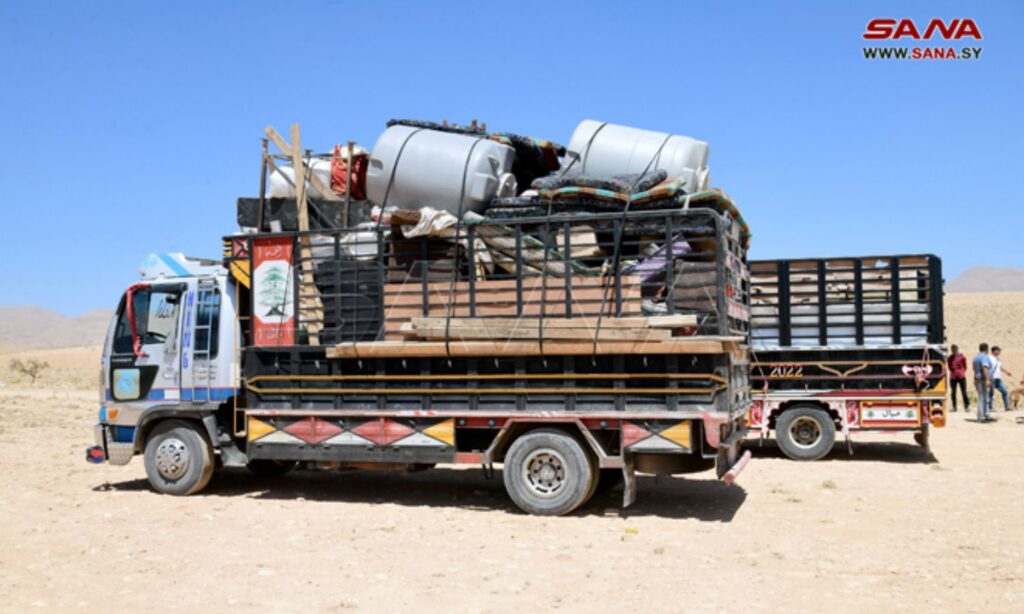Today, Thursday, July 11, a group of Syrian refugees returned from Lebanon to Syria as part of Lebanon’s “voluntary return” plan.
The official Syrian news agency (SANA) reported that 311 refugees returned through the Zemrani border crossing in the countryside of Damascus to their regions and villages, with relevant authorities recording their personal data and permanent residence addresses in their villages and towns.
This return follows a previous group who returned on May 14 through the Jousieh border crossing in the countryside of Homs and the Zemrani border crossing, comprising 300 Syrian refugees in two trips.
Lebanon officially refers to the Syrian refugees as “displaced persons” to reject what it considers the settlement of refugees in the country.
The Syrian Observatory for Human Rights (based in London) reported today, Thursday, that the head of the General Intelligence Directorate of the regime, Hussam Luka, visited the city of Talbiseh in the northern countryside of Homs to prepare for the opening of a “settlement center” for those wanted by security agencies in the area. This is part of the preparations for establishing a “safe zone” in regions with a significant number of “reconciliation factions” elements in the northern Homs countryside, in preparation for the return of Syrian refugees from Lebanon.
According to the Syrian Observatory, the initiation of settlements in the city and the preparation of the “safe zone” to receive Syrian refugees from Lebanon came at the request of Turkey and the United Nations, with pressure on the Russian side to accept the “settlements” and the “safe zone.”
In mid-May, Lebanese Minister of the Displaced Issam Sharafeddine confirmed that there are lists with the names of 2,500 Syrian refugees presented to the Lebanese General Security, being worked on to send to the Syrian National Security Office for follow-up.
Is Syria safe?
A report by the Syrian Network for Human Rights (SNHR) on July 9 documented that a Syrian young man from the Barzeh neighborhood in Damascus, named Ahmad Nimer al-Halli, was arrested by the Syrian regime forces at the beginning of June at one of the checkpoints. He was then taken to the Palestine Branch (235) of the Military Intelligence Division.
According to the SNHR, al-Halli was a refugee in Lebanon and was forcibly returned by Lebanese General Security to the Syrian border with a group of refugees. He was arrested immediately upon his return without an arrest warrant or informing his family, and he was prevented from communicating with his family or a lawyer. At the end of June, he was transferred to a hospital in Damascus in poor condition due to torture and remained in intensive care until his death on July 6.
On May 27, Amnesty International confirmed that human rights organizations unanimously agree that there is no place in Syria considered safe for the return of refugees.
Aya Majzoub, Deputy Director of the Middle East and North Africa Regional Office at Amnesty International, stressed the need for donor governments at the Brussels conference, especially European Union member states, to ensure that any funds pledged to support Syrian refugees in Lebanon do not contribute to human rights violations, including the forced deportation of Syrian refugees from Lebanon to Syria.
Majzoub pointed out that donor countries for Syria, and the refugee-hosting countries, should pressure the Lebanese authorities to stop deporting refugees to places where they are at risk of violations and lift the restrictions, as well as end the unprecedented crackdown on Syrian refugees. These actions are aimed at pressuring them to leave the country despite the risks repeatedly documented by humanitarian organizations and individuals, according to Majzoub.
In February, the United Nations Office of the High Commissioner for Human Rights reported that many Syrians who fled the war face gross human rights violations and abuses upon returning to Syria.
A report from the UN Human Rights Office documented violations and abuses committed by the government, de facto authorities, and other armed groups throughout Syria.
The violations mentioned in the report include arbitrary detention, torture, ill-treatment, sexual and gender-based violence, enforced disappearance, and kidnapping.
It also indicated that people were subjected to extortion and property confiscation, and deprived of identity cards and other documents. While all Syrian residents are subjected to such violations and abuses, returnees appear to be more at risk.
In addition to warnings from human rights organizations and the United Nations, the newspaper Asharq Al-Awsat reported in early June that a Lebanese parliamentary source said that around 1,100 Syrians who voluntarily returned to their towns were sent back to Lebanon by an official decision of the regime, with only 400 accepted for return. The regime considers most of the displaced as undesired and a security and demographic threat to its existence.











